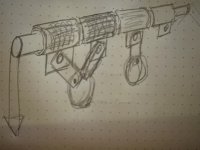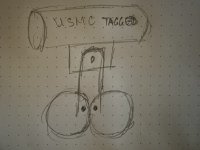If you were to build a permanent target range with steel targets at every 100 yard increments going out to 1000 yards, how would you do it.
I am building a target range setup at my ranch, will have steel target setups at 100 yard increments out to 1000+. This will be a permanent setup and will not need to move it anytime soon. I am trying to come up some ideas on installation, hangers, sizes, etc. Right now, I am thinking of welding a pipe rack at each 100 yard increment and having a series of steel gongs hanging down at each, kind of like the attached, hanging from straps.
The 100 yard will also have a stand for paper.
I am new at this, i havent seen what is typical for long-range target ranges.
1. Any other target concepts I should consider? I may add a few popping targets at the closer increments
2. What is a typical size gong(s) / plate(s) you would expect to see at 1000 yard shot - where someone relatively new to ELR but with a little instruction can still hit it, but its still a challenge.
3. At those 800-1000 yards distances, any brand of gong / steel or any certain setup aid in hearing/seeing whether target was hit?
4. what about sizes from ~300 yards to 700 yards?
5. I am thinking of using the rubber straps because easier to install/replace than a chain hanging type system. Ideally would have gongs with a tube welded in the top to put on the pipe crossbar but cant find those. Im also worried about the targets sliding down the post and coming too bunched up together, but not sure how to address that other than building a separate rack

I am building a target range setup at my ranch, will have steel target setups at 100 yard increments out to 1000+. This will be a permanent setup and will not need to move it anytime soon. I am trying to come up some ideas on installation, hangers, sizes, etc. Right now, I am thinking of welding a pipe rack at each 100 yard increment and having a series of steel gongs hanging down at each, kind of like the attached, hanging from straps.
The 100 yard will also have a stand for paper.
I am new at this, i havent seen what is typical for long-range target ranges.
1. Any other target concepts I should consider? I may add a few popping targets at the closer increments
2. What is a typical size gong(s) / plate(s) you would expect to see at 1000 yard shot - where someone relatively new to ELR but with a little instruction can still hit it, but its still a challenge.
3. At those 800-1000 yards distances, any brand of gong / steel or any certain setup aid in hearing/seeing whether target was hit?
4. what about sizes from ~300 yards to 700 yards?
5. I am thinking of using the rubber straps because easier to install/replace than a chain hanging type system. Ideally would have gongs with a tube welded in the top to put on the pipe crossbar but cant find those. Im also worried about the targets sliding down the post and coming too bunched up together, but not sure how to address that other than building a separate rack



